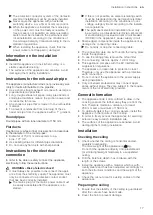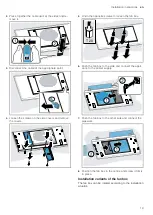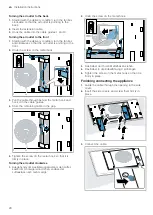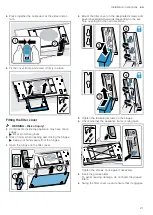
Installation instructions
en
17
▶
The protective conductor system of the domestic
electrical installation must be properly installed.
▶
Never equip the appliance with an external
switching device, e.g. a timer or remote control.
▶
When the appliance is installed, the mains plug
of the power cord must be freely accessible. If
free access is not possible, an all-pole isolating
switch must be installed in the permanent elec-
trical installation according to the conditions of
Overvoltage Category III and according to the in-
stallation regulations.
▶
When installing the appliance, check that the
power cable is not trapped or damaged.
Information on the installation
situation
¡
Install this appliance on the kitchen ceiling or a
stable suspended ceiling.
¡
The surfaces of the appliance are sensitive. Avoid
damaging them during installation.
Instructions for the exhaust air pipe
The appliance manufacturer does not provide any war-
ranty for faults attributable to the pipeline.
¡
Use a short, straight exhaust air pipe with as large a
pipe diameter as possible.
¡
Long, rough exhaust air pipes, many pipe bends or
small pipe diameters reduce the suction power and
increase the fan noise.
¡
An exhaust air pipe that is made of non-combustible
material.
¡
To prevent condensate from returning, fit the ex-
haust air pipe from the appliance with a 1° gradient.
Round pipes
Round pipes with an inner diameter of 150 mm.
Flat ducts
Use flat ducts whose inner cross-section corresponds
to the diameter of the round pipes:
¡
Diameter of 150 mm corresponds to ap-
prox. 177 cm².
¡
Use sealing strips for different pipe diameters.
¡
Do not use any flat ducts with sharp bends.
Instructions for the electrical
connection
In order to be able to safely connect the appliance
electrically, follow these instructions.
WARNING ‒ Risk of electric shock!
¡
It must always be possible to disconnect the appli-
ance from the electricity supply. The appliance must
only be connected to a protective contact socket
that has been correctly installed.
▶
The mains plug for the mains power cable must
be easily accessible after the appliance is in-
stalled.
▶
If this is not possible, an all-pole isolating switch
must be integrated into the permanent electrical
installation according to the conditions of over-
voltage category III and according to the installa-
tion regulations.
▶
The permanent electrical installation must only
be wired by a professional electrician. We recom-
mend installing a residual-current circuit breaker
(RCCB) in the appliance's power supply circuit.
¡
Sharp-edged components inside the appliance may
damage the connecting cable.
▶
Do not kink or trap the connecting cable.
¡
The connection data can be found in the rating plate
inside the appliance.
¡
To see the rating plate, remove the odour filter.
¡
The connecting cable is approx. 1.30 m long.
¡
This appliance complies with the EC interference
suppression regulations.
¡
The appliance corresponds to protection class 1.
Therefore, only use the appliance with a protective
earth connection.
¡
Do not connect the appliance to the power supply
during installation.
¡
Only a licensed professional may connect appli-
ances without plugs. They are subject to the require-
ments of the local electricity provider.
General information
¡
The appliance finds it more difficult to draw in the
cooking vapours the further away they are from the
hob. Therefore maintain a distance of at least
700 mm and a maximum of 1500 mm.
¡
To optimally detect the cooking vapours, install the
appliance in the middle of the cooktop.
¡
In order to freely access the appliance for servicing,
select an easy-to-reach installation site.
¡
The surfaces of the appliance are sensitive. Avoid
damaging them during installation.
Installation
Checking the ceiling
1.
Check whether the ceiling is horizontal and ad-
equately load-bearing.
The max. weight of the appliance is 40 kg.
Do not fit the appliance directly onto plasterboard
(or similar lightweight materials) in a suspended
ceiling.
2.
Drill the borehole depth in accordance with the
length of the screws.
3.
Install the appliance with a material which is suffi-
ciently stable and has been adjusted accordingly for
both the structural conditions and the weight of the
appliance.
4.
Check the cut-out area for existing cables of other
appliances.
Preparing the ceiling
1.
Ensure that the stability of the ceiling is guaranteed
after the cut-outs have been made.
2.
Cover the hob to prevent damage.








































